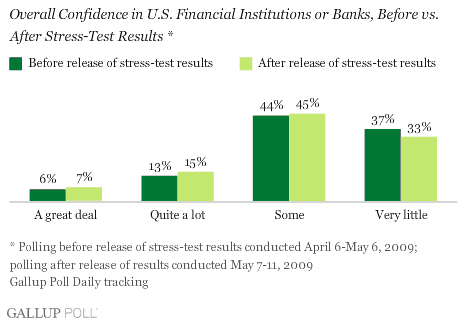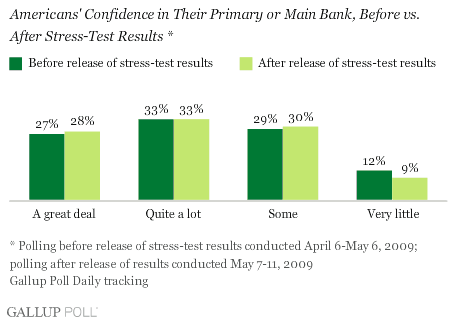PRINCETON, NJ -- Given the shaky nature of Americans' overall confidence in U.S. banks, many government and financial leaders would have been happy if the recent "stress test" results did no further harm to banking confidence. ÓĹĂŰ´«Ă˝Poll Daily tracking shows that confidence in banks actually improved slightly, but to a statistically significant degree, after the public release of the stress-test results last week.

Small but Significant Increase
The combined percentage of Americans saying they have "a great deal" or "quite a lot" of confidence in U.S. banks averaged only 19% over the four weeks prior to the release of the so-called banking stress-test results last Thursday. During the subsequent five days, the percentage of Americans with this level of confidence in U.S. banks increased significantly to 22%. At the same time, those saying they have "very little" confidence declined from 37% to 33%.
Many more Americans express confidence in their main or primary bank -- the place where they do most of their banking business -- than in U.S. banks generally. Before the stress-test information was released, 60% said they had a great deal (27%) or quite a lot (33%) of confidence in their main bank, while after the release, 61% did so -- essentially unchanged. On the other hand, prior to the release, 12% of Americans expressed very little confidence in the bank where they do most of their banking, while after it, only 9% said this -- a slight, but significant, decline.

Commentary
Federal Reserve Board Chairman Ben S. Bernanke, U.S. Treasury Secretary Tim Geithner, and banking regulators did a good job of using the behavioral economics art of "framing" the results of the banking stress tests. While it is difficult to get much credit for avoiding a potential disaster, a poor presentation of the stress-test results could have had a significant negative impact, not only on the overall public perceptions of U.S. banks, but also among global investors. In this regard, the measure of success in releasing the results of the banking stress tests involved a very low hurdle -- simply do no harm.
The fact that presentation of the results may actually have helped generate a little positive momentum toward rebuilding Americans' confidence in the U.S. banking system means the release was an even greater success. While it is possible that this improvement also benefited to some degree from the recent upturn in overall consumer confidence on the margin, and a few percentage points' improvement in how Americans view U.S. banks may not seem like much, that is not the case. Americans' perceptions of banks and other U.S. institutions, , typically show a similar level of change over years -- not days or weeks. And, as Bernanke noted in a speech Monday night, the efforts -- not to mention the actual ability -- of U.S. banks to raise capital after the release of the stress-test results are even more encouraging.
For the first time since the financial crisis got completely out of control in mid-September 2008, it appears as though the Treasury and the Fed may have achieved a modicum of financial stability. There is a long way to go before the same can be said about the functioning of the credit markets, but a return to financial stability, if that is indeed what has happened, fulfills a key prerequisite to economic recovery.
Survey Methods
Results are based on telephone interviews with 7,249 national adults, aged 18 and older, conducted April 6 to May 6, 2009, and 3,300 adults interviewed May 7-11, 2009, as part of the ÓĹĂŰ´«Ă˝Poll Daily tracking. For results based on these samples of national adults, one can say with 95% confidence that the maximum margin of sampling error is ±2 percentage points.
Interviews are conducted with respondents on land-line telephones (for respondents with a land-line telephone) and cellular phones (for respondents who are cell-phone only).
In addition to sampling error, question wording and practical difficulties in conducting surveys can introduce error or bias into the findings of public opinion polls.
